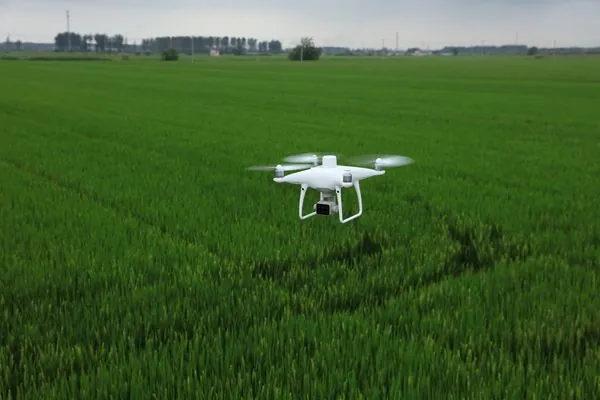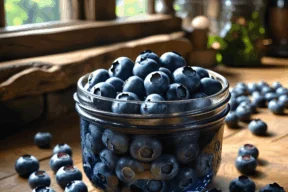Farm Facts That Feed You
Recent Agriculture Innovations in America

Recent Agriculture Innovations in America
Compilation of Data by Julie Murphree, Arizona Farm Bureau Director of Strategic Communications
American agriculture has seen remarkable technological advancements in recent years, driven by the need to increase productivity, enhance sustainability, and address challenges like climate change, labor shortages, and food security. Below is an overview of some of the most significant recent technology innovations shaping the industry as of 2025:
1. Precision Agriculture
Precision agriculture continues to evolve, leveraging tools like GPS, drones, sensors, and data analytics to optimize farming practices. Farmers can now monitor soil conditions, crop health, and weather patterns in real time, applying water, fertilizers, and pesticides only where needed. For example, GPS-guided tractors and auto-steering equipment allow for precise planting and harvesting, reducing waste and improving yields. The adoption of these technologies has grown, about 27% of U.S. farms used precision agriculture practices as of mid-2023, indicating room for further expansion.
2. Artificial Intelligence (AI) and Machine Learning
AI is transforming agriculture by enabling smarter decision-making. AI-powered systems, such as John Deere’s “See & Spray” technology (developed through the acquisition of Blue River Technology), use computer vision to distinguish crops from weeds, applying herbicides only to unwanted plants. This reduces chemical use by up to 90% in some cases. Similarly, companies like Arva Intelligence use AI to analyze farm data—genetics, soil fertility, and climate—to provide customized crop planning recommendations. AI is also being integrated into drones and sensors for pest detection and yield prediction.
3. Robotics and Automation
Robotic systems are addressing labor shortages and boosting efficiency. Autonomous tractors, like those from John Deere, can plant, spray, or harvest crops with minimal human intervention, controlled via smartphone apps. Robotic harvesters, such as those developed by Tevel Aerobotics Technologies in partnership with Kubota, use AI to pick ripe fruit gently, increasing efficiency and reducing waste. Additionally, innovations like the LaserWeeder employ AI-driven lasers to zap weeds without chemicals, while lightweight autonomous machines reduce soil compaction during planting.
4. Drones and Aerial Imaging
Drones equipped with advanced cameras and sensors are increasingly used for crop monitoring, livestock management, and even targeted spraying. They provide high-resolution data on plant health, soil moisture, and field conditions, allowing farmers to respond quickly to issues. For instance, Kray Technologies’ unmanned drone crop sprayers can cover up to 1,200 acres per day, cutting application costs significantly while boosting yields by 20-40%.
5. Internet of Things (IoT) and Smart Farming
IoT devices, such as soil moisture sensors and livestock activity monitors, collect real-time data, enabling farmers to manage resources efficiently. Webee’s SmartFarm platform, recognized in 2021 as a top agricultural SaaS product, offers a no-code solution for remote farm monitoring, integrating data from sensors and weather forecasts. This trend is supported by the rollout of 5G networks, which enhances connectivity in rural areas, allowing for seamless data transmission and automation.
The University of Arizona is doing some leading research work with livestock collars for virtual fencing advances. See Details in the Arizona-specific innovations.
6. Biotechnology and Gene Editing
Advances in biotechnology are producing climate-resilient crops that withstand drought, heat, and pests. Gene editing techniques, like CRISPR, allow for precise enhancements without the controversies of traditional GMOs. Minichromosome technology is another innovation, improving plant traits without altering their core genetics, promoting biodiversity and sustainability. Biological pesticides and biocontrol agents are also reducing reliance on synthetic chemicals.
7. Vertical Farming and Controlled Environment Agriculture (CEA)
Indoor vertical farming is gaining traction, especially in urban areas or regions with harsh climates. Using hydroponics or aeroponics, these systems grow crops in stacked layers with nutrient-rich water, cutting water use by up to 90% compared to traditional methods. Companies are integrating AI and IoT to control lighting, humidity, and nutrients, ensuring year-round production with minimal environmental impact.
8. Bee Vectoring and Pollination Tech
Innovations like Bee Vectoring Technologies (BVT) use commercially raised bees to deliver natural fungi (e.g., Vectorite) to crops, enhancing disease resistance and pollination without chemicals. Meanwhile, MIT’s robotic insects, still in development, aim to pollinate crops rapidly, potentially revolutionizing fruit and vegetable production as natural pollinators decline.
9. Sustainable Practices and Data Analytics
Farm management software and data analytics tools help farmers track soil quality, weather, and resource use, optimizing yields while reducing costs. Platforms like Croptracker’s Harvest Quality Vision (HQV) use AI to assess crop quality during harvest, ensuring consistency. Sustainable practices, such as no-till farming and closed-loop wastewater treatment systems, are also supported by tech, recycling water and nutrients back into fields.
10. Blockchain and Supply Chain Transparency
Blockchain technology is being adopted to trace food from farm to table, ensuring quality and safety. Walmart uses Hyperledger to detect unwholesome food in real time, while startups are integrating blockchain with IoT to monitor crop conditions and logistics, enhancing transparency for consumers and regulators.
Impact and Challenges
These innovations are boosting productivity—U.S. agricultural output has increased significantly since the mid-20th century, with corn yields quadrupling and soybean yields doubling by 2011—and supporting sustainability goals, like reducing emissions and water use. The USDA’s Agriculture Innovation Agenda aims to increase production by 40% while halving the environmental footprint by 2050, aligning with many of these technologies. However, challenges remain: high upfront costs, limited rural broadband access, and data-sharing concerns hinder widespread adoption, particularly for small farmers.
In summary, American agriculture is at the forefront of a tech-driven revolution, blending AI, robotics, and sustainable practices to meet future demands. As these technologies mature, they promise to make farming more efficient, resilient, and environmentally friendly, though equitable access and infrastructure improvements will be key to their success.
Agriculture Innovations Specific to Agriculture in Arizona
Arizona’s unique desert climate and limited water resources have driven the development of innovative agricultural practices tailored to its environment. Here are some key innovations specific to agriculture in Arizona:
- Ancient and Modern Irrigation Systems
Arizona has a long history of irrigation, starting with the Hohokam people over 1,000 years ago, who built extensive canal systems to farm in the arid region. Today, this legacy continues with modern advancements like the photovoltaic (PV) array installed over a half-mile of irrigation canal south of Phoenix. This system reduces water evaporation by up to 50% while generating significant electricity, addressing both water scarcity and energy needs in the desert. - Drip Irrigation
Widely adopted in Arizona, drip irrigation delivers water directly to plant roots through low-volume emitters, minimizing waste in the state’s dry conditions. This method improves water efficiency where practical since not every soil condition or farm structure can make application of this technology. - Automated Farm Technology
Arizona’s private sector has pioneered automated tractors with guidance and auto-steering systems. These innovations reduce soil disturbance, increase efficiency, and optimize planting and harvesting in large-scale operations, such as those in Maricopa and Pinal Counties, which lead in cotton and hay production. - Unmanned Aircraft Systems (UAS)
Universities like Arizona State University are developing UAS to pollinate crops like date palms, a growing industry in the state. These drones enhance precision agriculture, reducing labor costs and improving yields in Arizona’s specialty crop sectors. - Sustainable Soil Health Solutions
Arizona innovators are producing microalgae-based products to improve soil health. These sustainable solutions help retain moisture and nutrients in the sandy, arid soils, supporting crops like pecans, which thrive in Cochise County, home to the world’s largest pecan grove. - Water Conservation Programs
The Arizona Groundwater Management Act regulates irrigation in Active Management Areas, limiting expansion to lands irrigated between 1975 and 1980. The voluntary Best Management Practices (BMP) Program, introduced in 2003, encourages farmers to adopt efficient irrigation techniques, such as laser-guided land grading and tailwater reuse, tailored to Arizona’s water-limited environment. - Climate-Controlled Systems
To combat extreme heat, Arizona farmers use climate control technologies like shade structures and evaporative cooling. These systems are vital for high-value crops like vegetables ensuring consistent production despite harsh desert conditions. - High-Value Crop Diversification
Arizona’s year-round growing season has spurred innovation in specialty crops like pecans, wine grapes, and leafy greens. For example, the Arizona Leafy Greens Program, established in 2007, sets strict food safety protocols for lettuce and spinach, leveraging technology to maintain quality from farm to table. - Virtual Fencing Technology for Precision Livestock Management
The Yuma Center of Excellence for Desert Agriculture (YCEDA), a public-private partnership, targets industry priorities like water management and food safety. Meanwhile, the Maricopa Agricultural Center acts as a testbed for scaling innovations, ensuring they meet Arizona farmers’ needs.
These innovations reflect Arizona’s ability to adapt agriculture to its arid climate, focusing on water efficiency, sustainability, and technology. They support the state’s nearly $31billion agricultural economy, which excels in dairy, beef, lettuce, and cotton production.
University of Arizona Research Efforts in the Innovation in Agriculture Arena
The University of Arizona (UArizona) is a leader in agricultural innovation, particularly tailored to the unique challenges and opportunities of Arizona’s arid environment. Through its College of Agriculture, Life & Environmental Sciences (CALES), the Arizona Experiment Station, Extension and various research centers, UArizona drives advancements in sustainable farming, water management, and technology integration to bolster agriculture in the state and beyond. Here’s an overview of its contributions to agricultural innovation in Arizona as of 2025:
Key Research Initiatives
- Technology and Innovation Hubs
UArizona has established innovation hubs at the Maricopa Agricultural Center (MAC), Yuma Agricultural Center (YAC), Campus Agricultural Center (CAC), and Biosphere 2. These hubs serve as collaborative spaces where faculty, growers, ranchers, and industry partners develop and test cutting-edge technologies. Examples include precision agriculture tools, automated harvesting systems, and water-efficient irrigation methods. These hubs also provide students with hands-on research and entrepreneurial opportunities, enhancing workforce readiness. - Institute for Sustainable Food, Water, and Agricultural Systems (ISFWAS)
UArizona is establishing ISFWAS as a flagship institute to address technical, policy, and human dimensions of agriculture, food, and water systems. This initiative fosters interdisciplinary collaboration with community and regional partners to develop system-level solutions. It aims to tackle Arizona’s challenges, such as declining water supplies in a dry climate, by promoting climate-resilient and sustainable agricultural practices. - Center for Soil Health (CSH)
The CSH focuses on healthy soils agriculture to maintain and restore soil health—a critical issue in Arizona’s arid landscapes. By integrating producers into its decision-making structure, the center ensures research is practical and directly applicable to local farmers. This work supports long-term agricultural productivity amid environmental stressors like drought and soil degradation. - Controlled Environment Agriculture Center (CEAC)
Located at the Campus Agricultural Center, the CEAC advances controlled environment agriculture (CEA), such as greenhouse and vertical farming systems. This research optimizes crop production in Arizona’s extreme climate, producing high-value crops like tomatoes and peppers with minimal water and environmental impact. The CEAC’s facilities, including advanced greenhouses, support both education and practical experimentation. - Cyber Experiment Station
The Cyber Experiment Station is the most unique among our peers in other states. We are not aware of any other state that has expertise in information technology within their organization, and as a result, most must rely on generic university resources for that support. Instead, at the Arizona Experiment Station (AES), the staff and infrastructure are finely tuned to the challenges and needs of the AES and the stakeholders across the state. The staff includes web app developers and data scientists and the infrastructure includes high-speed data portals, sensors, data science and data management, and decision support tools that are web-based applications such as Desert AgWise, are made available to as many users as possible.- CyVerse started out as the iPlant Collaborative in 2008 – it was the largest ever investment into NSF’s Directorate for Biology for working with genomic data in the Plant Science at $50 million dollars. IPlant grew quickly in popularity, got another $50 million dollars in 2013, and in 2016 it was renamed CyVerse to reflect the new broader mission to support all life sciences. Today CyVerse supports a range of projects across astronomy, defense, health, earth, and life sciences.
Focus Areas and Innovations
- Water Productivity and Efficiency:
Arizona’s agriculture faces significant water scarcity challenges. Researchers like Dr. Isaya Kisekka integrate data from soils, weather, and plant measurements to improve water productivity. In Yuma County, a 2022 economic impact study highlighted by UArizona found that the region uses less than one acre-foot of water per $1,000 of vegetable sales, showcasing efficient water use that UArizona aims to further enhance through innovation. - Climate-Smart Technologies:
UArizona develops technologies to adapt to a dry climate. This includes solar-powered greenhouses, drone-based crop monitoring, and precision planting systems demonstrated at events like the 2024 Desert Difference AgTech Conference in Yuma.
These tools help farmers produce more food with fewer resources, critical for Arizona’s $31 billion agricultural economy. - Tribal Collaboration:
Recognizing Arizona’s 22 federally recognized tribes, UArizona partners with Native Nations to incorporate traditional knowledge into sustainable agriculture.
Projects focus on digital soil mapping and water-smart practices to boost productivity on tribal lands, aligning with the university’s Tribal Consultation Policy. - Economic and Industry Impact:
The Yuma Center of Excellence for Desert Agriculture (YCEDA), a public-private partnership, targets industry priorities like water management and food safety. Meanwhile, the Maricopa Agricultural Center acts as a testbed for scaling innovations, ensuring they meet Arizona farmers’ needs.
Broader Implications
UArizona’s efforts stem from the Presidential Advisory Commission on the Future of Agriculture & Food Production in a Dry Climate, launched in 2022. The commission’s recommendations emphasize making Arizona a global leader in desert agriculture through transformative technologies and partnerships. By leveraging its land-grant mission, UArizona not only supports Arizona’s agricultural sector — evidenced by Yuma’s more than $4 billion vegetable sales ranking third nationally (though ranking at the top during the winter) — but also provides scalable solutions for arid regions worldwide.
In summary, UArizona’s research in agricultural innovation in Arizona combines advanced technology, sustainable practices, community and grower and rancher collaboration to address the state’s unique environmental challenges, ensuring a resilient and prosperous agricultural future.
The UArizona has been actively involved in researching virtual fencing (VF) technology as an innovative tool for livestock management and sustainable rangeland stewardship. This research is part of a broader effort to integrate traditional ranching practices with emerging technologies to address ecological, economic, and management challenges in the arid Southwest and beyond.
Details of Virtual Fencing
Virtual fencing is a precision livestock management technology that uses GPS-enabled collars to control the movement of grazing animals without the need for physical fences. These collars communicate with a network — typically via radio signals to a base station and then through cellular data to a web-based application — allowing ranchers to set virtual boundaries. When livestock approach these boundaries, the collars emit an audio cue (e.g., beeps) to warn them. If the animals cross the boundary, a mild electric stimulus is applied to encourage them to turn back. Over time, livestock learn to respond to the audio cue alone, reducing the need for shocks.
This technology offers flexibility compared to traditional fencing, enabling ranchers to adapt grazing patterns to changing environmental conditions, protect sensitive areas, and reduce labor and material costs associated with physical fences.
UArizona’s Research Focus
UArizona’s virtual fencing research is led by experts in the School of Natural Resources and the Environment (SNRE), often in collaboration with the Arizona Cooperative Extension, the Arizona Experiment Station, and external partners like The Nature Conservancy and private ranching operations. The research is conducted at sites such as the Santa Rita Experimental Range (SRER), a long-standing ecological research station south of Tucson.
Key aspects of their work include:
- Testing Efficacy and Functionality
Researchers evaluate how well virtual fencing works in real-world scenarios, particularly in the rugged, arid landscapes typical of Arizona. This involves deploying collars on cattle and assessing their ability to contain herds within designated areas, excluding them from ecologically sensitive zones (e.g., riparian areas), or move them across pastures. Trials focus on the reliability of GPS signals, the animals’ learning rates, and the durability of the collars in harsh environments. - Ecological Impacts
A major goal is to understand how virtual fencing can enhance rangeland health. By allowing precise control over grazing patterns, researchers study its effects on vegetation recovery, soil health, and biodiversity. For example, they explore whether excluding cattle from recently burned areas or low-vegetation zones promotes plant regrowth, addressing limitations of static physical fences that fragment landscapes and restrict adaptive management. - Economic Analysis
In partnership with the UArizona Department of Agricultural and Resource Economics, the research examines the cost-effectiveness of virtual fencing. This includes comparing the upfront costs of collars and infrastructure (e.g., base stations) to the savings from reduced labor, maintenance, and installation of traditional fencing. The aim is to quantify the return on investment for producers, especially at commercial scales, to determine its viability for widespread adoption. - Practical Implementation
UArizona researchers develop best practices for deploying and managing virtual fencing systems. This includes strategies for collar labeling (pairing collar IDs with animal ear tags), retrieving lost collars (using features like GPS tracking or high-visibility colors), and organizing herds in software for real-time monitoring. These efforts ensure the technology is user-friendly for ranchers and land managers.
Partnerships and Funding
The research is supported by multiple entities, reflecting its interdisciplinary and applied nature:
- Arizona Experiment Station and the Marley Endowment for Sustainable Rangeland Stewardship provide funding and resources.
- Arizona Cooperative Extension facilitates outreach, sharing findings with producers through workshops, reports, and digital media.
- The Nature Conservancy collaborates on conservation-focused outcomes, such as aligning grazing with ecological goals.
- Private partners, like Santa Rita Ranch, Inc., and technology providers (e.g., Vence Corporation, now part of Merck Animal Health), supply equipment and practical insights.
A notable project is tied to the Western Sustainable Agriculture Research and Education (SARE) program, funded by the USDA’s National Institute of Food and Agriculture. This initiative, under project number WPDP22-016, emphasizes collaborative training for virtual fencing implementation under environmental uncertainty, with resources hosted on the Rangelands Gateway website.
Key Findings and Implications
While specific results may vary by study, UArizona’s work highlights several benefits and challenges:
- Benefits: Virtual fencing offers greater management flexibility, reduces the ecological footprint of physical fences, and supports adaptive grazing strategies in response to drought, wildfires, seasonal shifts and more.
- Challenges: High initial costs for collars and infrastructure, potential GPS signal issues in remote areas, and the need for rancher training are hurdles to overcome.
The research has broad implications for rangeland management in the Southwest, where arid conditions and climate variability demand innovative solutions. By refining virtual fencing, UArizona aims to balance livestock production with conservation, supporting both ranching livelihoods and ecosystem health.
Broader Context
UArizona’s efforts align with similar research at other institutions, such as Colorado State University, Oklahoma State University, and Oregon State University, which test virtual fencing in diverse terrains and for various objectives (e.g., water quality, wildfire management). The University of Arizona stands out for its focus on arid ecosystems and its integration of extension services to bridge research and practice.
Completion Date
As for the completion date of this research, there is no single, definitive endpoint specified in available sources, as VF research is an evolving field with ongoing projects. The SARE-funded project mentioned above began in 2021 under award number 2021-38640-34695, with sub-project WPDP22-016, and has already produced significant outputs like the Virtual Fence User Guide and related publications by 2025. However, the technology’s development and refinement are iterative, with research likely extending beyond initial project timelines as new data and user experiences emerge. For instance, the University of Arizona’s repository noted a content freeze until November 22, 2024, suggesting active updates to research outputs around that time, but no hard completion date is explicitly tied to the VF research as a whole. Given the continuous nature of agricultural innovation and the University’s role in extension services, the research is slated to remain ongoing, with practical applications and findings being disseminated progressively rather than culminating in a fixed end date.
In summary, the University of Arizona’s virtual fencing research is a pioneering effort to modernize ranching while advancing sustainable land management. It combines cutting-edge technology with ecological and economic analysis, offering a model for how innovation can address the challenges of 21st-century agriculture in dryland regions.
Our Videos
View all VideosOur Latest Posts

The Scoop on Salt
For the longest time I never understood why every baking recipe always called for a teaspoon or two of salt, even if the baked good…

Training for Life’s Marathon: Fuel to Move, How Smart Nutrition Powers Everyone
This November, Tempe will once again become a stage for grit, perseverance, and pure human willpower as athletes dive into the waters, mount their bikes,…
Featured Recipes













